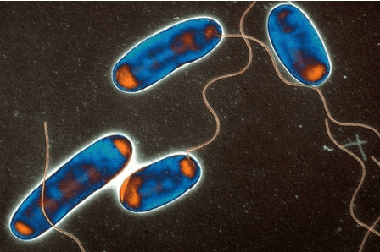Respiratory system >>>> Legionellosis is a multifaceted danger
Legionellosis is a multifaceted danger.

Legionellosis is a severe disease with severe intoxication of the body, high fever, accompanied by impaired renal function, cardiovascular, respiratory and central nervous system. Legionellosis is caused by a species of the bacteria Legionella pneumophilia.
Etiology and pathogenesis.
The causative agents of the disease are gram-negative rod-shaped aerobic bacteria of the genus Legionella of the family Legionellaceae. They are stable in the external environment, but they are sensitive to disinfectant solutions. Legionella's natural habitat is freshwater (especially stagnant water) and soil, where they live as saprophytes in blue-green algae, aquatic amoebas and other protozoa. Legionella are highly adaptable due to the fact that they reproduce in protozoa, which protect them from high concentrations of disinfectants, but can exist outside of other organisms.
Bacteria enter the human body through the inhalation of water or dust aerosols. The propagation mechanism is directly related to various technological processes that produce aerosol spraying of water (air conditioning, steam generation, fountains, showers, whirlpool baths, intubation, etc.) or air-dust works (earth and construction work, compressors). Human-to-human or animal-to-human transmission of bacteria has not been confirmed. There are risk groups, which include: the elderly, with weakened immunity, with endocrine disorders, with chronic diseases of the lungs, kidneys and smokers.
The entrance gates of infection are various parts of the respiratory system. Once in the body, legionella meet macrophages (representatives of the defense system) on their way, but the process of phagocytosis does not come to an end, since legionella, penetrating macrophages, inhibit the functionality of leukocytes. Legionella also multiply in polymorphonuclear neutrophils and in blood monocytes. The bacteria cause inflammatory and necrotic changes in the lung tissue by settling in infected alveolar macrophages. Legionella-infected macrophages are spread throughout the body by hematogenous and lymphogenous pathways. But the most terrible thing is not the very presence of Legionella, but the fact that when the bacteria dies, endotoxin is released. Endotoxin causes damage to various organs and systems, which leads to acute renal andrespiratory failure , as well as infectious toxic shock.
Clinic (signs of legionellosis).
There are several clinical forms of the course of legionellosis:
- A severe form of pneumonia ( Legionnaires' disease ) occurs with a wide range of clinical manifestations. The most typical symptoms are: persistent headache, muscle pain, rapidly rising temperature up to 40 0C, chills, difficulty speaking, nausea, vomiting, prolonged diarrhea (5-10 days). On days 2-4, against the background of pronounced intoxication, a dry cough and pain in the chest area appear. A physical examination reveals lung murmurs, increasing respiratory failure, dull heart sounds, low blood pressure, bradycardia, kidney failure, renal failure, and possible enlargement of the liver. On the roentgenogram, focal lesions are determined, which gradually merge, occupying vast areas. More severe cases are accompanied by the development of infectious - toxic shock in 1-2 days (until symptoms of respiratory tract damage appear), which is the cause of death. There is also a variety of the course of this form of the disease in the absence of radiological changes - acute alveolitis.
- Acute respiratory illness without pulmonary disease syndrome ( Pontiac Fever ) has varying degrees of course. It begins with mild malaise, nausea, anorexia, muscle pain, chills, sometimes photophobia, pain when turning the eyeballs. The temperature rises to 38 - 40 in Celsius. But a runny nose, cough, pain in the chest area are not observed in all patients. In severe cases of the disease, vomiting, insomnia, memory disorders, and hallucinations appear. This form of the disease has a short-term course and can be diagnosed only after a lapse of time.
- Acute febrile illness with eruptions (Fort Brag Fever) is similar in symptoms to Pontiac fever, but is initially accompanied by skin rashes that disappear after a few days.
- Pneumonia that develops in an immunocompromised setting (Pittsburgh pneumonia) affects people who are immunocompromised due to transplants or other serious illnesses that require immunosuppressive therapy. This disease is difficult, with high fever, general intoxication. The main symptoms are: cough, shortness of breath, chest pain, headache, abdominal pain, diarrhea. Skin abscesses and pulmonary edema may also develop. This form of the disease has a high fatality rate.
Differential diagnostics.
Since legionellosis is accompanied by a wide range of symptoms similar to many diseases, its diagnosis is very difficult, which is the cause of many deaths. Thus, differential diagnosis is the main condition for successful treatment and recovery.
- Firstly, legionellosis must be differentiated from other types of pneumonia: pneumococcal, staphylococcal, mycoplasma, blue-purulent infections and others.
- Secondly, to distinguish it from acute respiratory diseases, mouth-viral infection, ornithosis.
- Thirdly, to distinguish from fevers of various etiologies.
- Fourth, to differentiate with diseases of the gastrointestinal tract.
Distinctive features of legionellosis :
- incubation period from 5 hours to 10 days, on average 36 hours (clinical forms have a different incubation period)
- pronounced general intoxication of the body with lesions of the respiratory, cardiovascular systems, impaired renal function and liver damage (nausea, vomiting, diarrhea)
- fever with a rise in temperature up to 39-40 in Celsius
- tachycardia
- shortness of breath
- chest pain
- cough

Read

Read


























